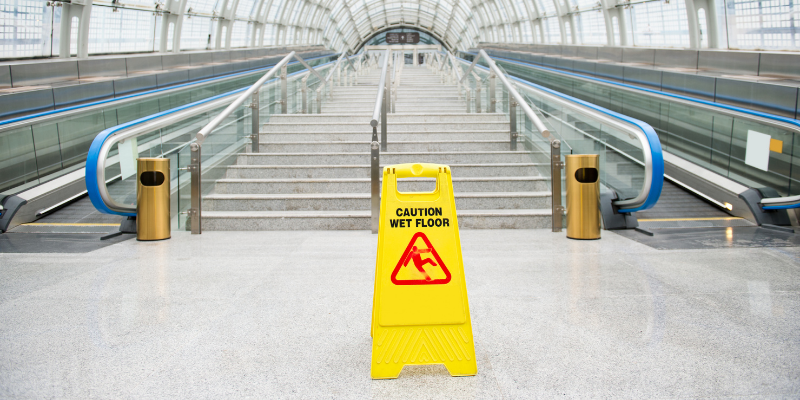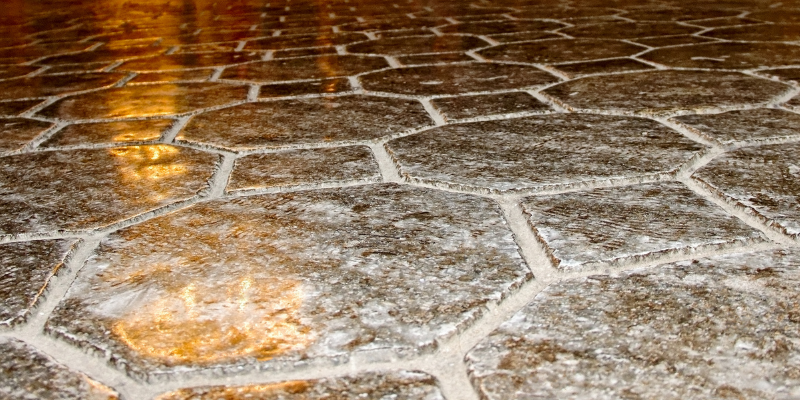Facilities invest a significant amount of money and time to install the best flooring for their functional and aesthetic needs. To protect this investment, in-house and/or contract custodial staff must clean and maintain floors properly. Too often, the
optimal chemicals, equipment, and processes are unknown, especially as they can fluctuate with the seasons. Here are 4 mistakes that many facilities unknowingly make during the winter months, along with remedies to ensure their floors make it through
to spring, unscathed by moisture from snow, ice, and the salt used to combat them.

1. Dismissing Mats
Sturdy mats and rugs should be every facility’s first defense against salt and moisture. In fact, an effective matting system can trap 90% of debris.
- A coarse, sturdy mat should be placed right outside the facility for the purpose of stomping off snow and dislodging salt particles before entering.
- Another mat to wipe shoes on should be placed directly inside each doorway to catch any remaining salt or moisture before it can be tracked into the facility.
- Depending on the type of facility, it may also be worth considering addition of a third waterproof mat to the side of select doors, where heavy snow boots can be placed to dry, as well as keeping towels handy to wipe up any wetness that makes
its way onto floors.

2. Letting Moisture Linger
When liquid, slush, or ice is spotted resting on floors, cleaning professionals should make every possible effort to remove it immediately. Not only is moisture a slip/fall hazard, but depending on the floor type, it can also seep into the floor and
cause mold growth beneath the surface or warping.
- If the amount of liquid is excessive, a wet/dry vacuum, like the Workman® 20,
may be the best tool to start. Take heed, however, that some sensitive flooring types when utterly soaked may crack if they are dried too quickly, like wood.
- Heat should also be avoided during the drying process, as it may cause damage to the finish or flooring itself.

3. Shrugging off Salt
Most cold-weather salts or ice melt products are made from Calcium Chloride, which is popular due to its affordability and relative effectiveness.
- Calcium Chloride is crystalline, and the rough texture of each individual crystal—most visible under a microscope—has the potential to scratch and abrade floor finish if tracked inside and dragged across or ground into the floor.
- Custodial staff should regularly vacuum floors to suck up these micro-abrasive particles. If equipped with a rotating brush, it should be off or removed entirely before vacuuming.
- When Calcium Chloride is dissolved in water, it creates Calcium Hydroxide and Hydrochloric Acid, both of which leave behind a noticeable white residue. If the residue is not promptly removed, it can chemically damage the finish, causing hazing
and premature degradation, which can also increase dirt embedment.
- If the residue is “fresh,” it can likely be removed with a dampsoft cloth. Older or more stubborn salt stains will require a thorough cleaning.

4. Cleaning with Whatever's in the Supply Closet
After vacuuming over and around an older or more stubborn salt stain, it is important to thoroughly clean it.
- Don't be misguided by advice on some websites to use a mixture of vinegar and water on salt stains. This “quick fix" will leave a residue of its own and is harsh on finish if concentrated too strongly.
- The temptation should also be resisted to use general cleaners or disinfectants facilities may already have on hand, and instead opt for a cleaner specifically formulated for finished floors. Otherwise, they risk damage from inappropriate pH levels
and ingredients, such as Hydrogen Peroxide, acids, Sodium Hypochlorite, etc.
No matter the floor type, Betco® has solutions to help facilities safely remove salt stains while maintaining the finish.

- Suitable for use on most hard floors, pHerfect is formulated with neutralizing
agents and surfactants to remove tough soils and neutralize common ice melt ingredients and byproducts, such as sodium, Calcium Hydroxide, and Hydrochloric Acid. Using pHerfect cuts labor by 50%, as there is no need for a separate neutralizing
step. Please note that this product is NOT recommended for use on surfaces that may be harmed by acid products.
- For Formica®*, marble, polished stone, or other acid-sensitive surfaces, Top Flite™ all-purpose
cleaner will suspend salt-related soils safely.
- For wood floors specifically, begin with I.F.T. (Intensive Floor Treatment) and
finish with Squeaky™ floor cleaner.
- For larger spaces or excessive salt levels, our GeneSys™ 15 cleaning
machine is designed to provide a risk-free and complete clean that mopping alone cannot, as well as suction excess water away from the floor surface.
If severe damage is already present, facility managers may need to hire a professional to replace a portion of floors or the entire floor itself. If the floor is in good condition, however, and these 4 mistakes are avoided, they should be able to
successfully escape the floor care perils of winter weather.
*Formica® is a trademark of The Diller Corporation.